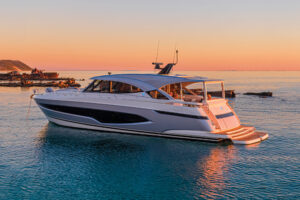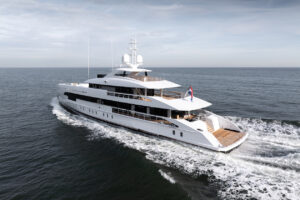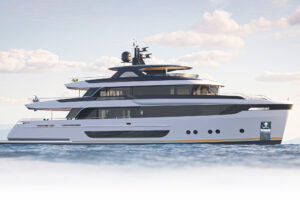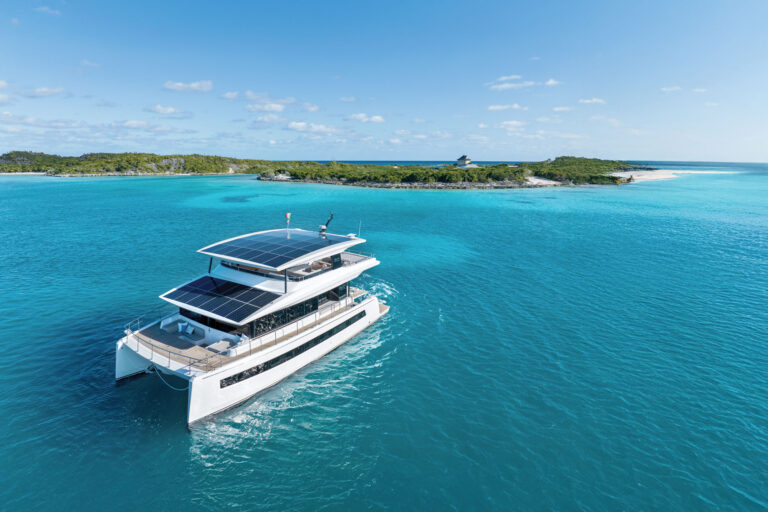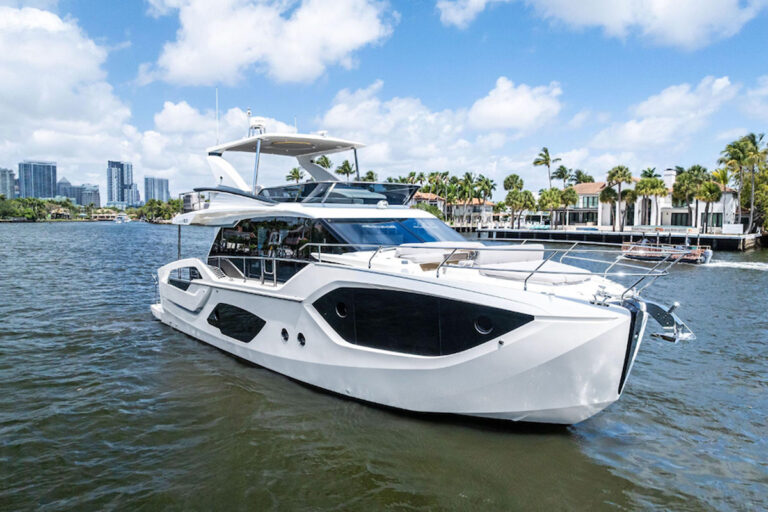In the big business of boating, Tony Fleming is, in a sense, retro. He is neither a corporate climber nor an entrepreneur seeking a new challenge. He is a boatbuilder, and it shows in his boats. Each is a purposeful design and a refinement of the last, and each new Fleming 75 should be no different.
Fleming has delivered 126 55-footers since I tested that model in 1995. Loyal customers of his first design have been pressing for a larger one that will allow them to continue their lifestyle on the water.
“Our customers tend to be experienced cruising couples who run their boat themselves”, Fleming said. “This sort of cruising requires comfort and reliability.”
The Fleming 75 is designed to reach that audience, with classic lines that can be traced back to the earliest days of America’s trawler yacht craze and that are as satisfying now as they were then. While this is not an unfamiliar theme, Fleming’s boats differ in their details. There isn’t a system on the 75 he hasn’t tweaked, and most incorporate unique features developed during his 40-year obsession with boatbuilding.
A good example is Fleming’s commitment to noise and vibration attenuation. The 75’s drive line incorporates an Aquadrive system that functions as a thrust bearing, transmitting thrust directly to the hull structure. The connection to the gearbox is through a constant velocity joint. This minimizes alignment problems and lets the engine float on a resilient mounting system.
The Aquadrive units cost $38,000, and Fleming insists the investment is worth it. I can understand why. Coupled with a generous application of lead foam insulation, the units help make the 75 one of the quietest rides on the water. I recorded just 69 decibels in the pilothouse at maximum speed.
On modern yachts, access to machinery and systems is too often an afterthought. This is not the case on the 75. Her 20-foot-long engineroom made our test boat’s pair of 1,400 hp Caterpillar 3412s look a tad small. Engines and generators draw and return fuel to two 1,250-gallon tanks along the forward engineroom bulkhead. A pair of 250-gallon auxiliary tanks re-supply the mains by gravity feed or a transfer pump, with an in-line filter and flow counter. Two 27.5kW Onan generators with sound shields are standard, however, those cruising the tropics will want the optional pair of 32kW Northern Lights units fitted with custom sound shields.
The 75 has a handlaid, solid fiberglass hull that’s 2 inches thick on the bottom and 1 3/8 inches thick on the topsides. A network of fiberglass/foam web frames, plywood bulkheads and full-length box section fiberglass stringers supports the hull. The deep keel sections are foam-filled and fiberglass-sealed. Balsa-coring stiffens the superstructure and decks. The hull-deck joint is bonded, mechanically fastened and fiberglassed internally. A vinylester skin coat is used below the waterline. The gelcoat finish is excellent.
The 75’s deck space is not compromised for interior volume. The flying bridge is expansive, with companion seating and a pop-up electronics console at the helm. The lounge area has a wet bar, a fridge and a grill.
An extended hardtop can cover the lounge area, although there is a second lounge below, on the shaded portion of the afterdeck. The boat deck can accommodate a 15-foot tender.
Those fond of the 55’s rich, satin-finished teak interior will find more of the same aboard the 75. The layout is casual. The main deck has an open arrangement with an L-settee, a table and two chairs. Galley counters are finished in granite, and an adjacent dining area seats six. Refrigeration is 110-volt AC, and two 4,000-watt inverters, with the house batteries, can keep things cold without running a generator.
Owner and guest accommodations are forward of the engineroom, accessible from the pilothouse in the standard layout. Our test boat also had direct access to the master stateroom from the saloon. The master has a king berth, a desk/vanity and a head with whirlpool bath. Each of the two guest staterooms has a private head with separate shower.
The side deck engineroom access also leads to a crew/guest stateroom with two berths and an enclosed head. The space is finished to the same standard as the rest of the yacht.
The raised pilothouse’s L-settee and table provide a delightful perch. The helm is shiplike in design, and a day head and flying bridge access are a few steps away. Experienced cruising couples will have no problem handling the 75 in close quarters, as visibility and deck access from the pilothouse and flying bridge are excellent.
Wide side decks lead from the cockpit and afterdeck forward to the Portuguese bridge and foredeck. Our test boat had a remote station with throttle and thruster controls aft on the boat deck, and one hidden cleverly in a fold-down console in the cockpit. I would prefer the plug-in control unit offered on the Portuguese bridge, which would allow the captain full view of the side decks. The line handler will appreciate the warping winches in the cockpit and the capstan on the bow.
The 75 has a semi-displacement hull, which Fleming prefers.
“While full-displacement hulls may be suited for those who dream of wandering the oceans, they are a compromise when pressed into more conventional service”, he said.
I agree. The 75 can chug along earning mileage points, or she can sprint. Our test boat’s pair of 1,400 hp Caterpillar 3412s burned 24 gallons per hour at 9.6 knots, and a bit less than 100 gallons per hour at 20 knots, according to the Caterpillar electronics. Such versatility is attractive.
The optional 800 hp Caterpillar 3406Es trim the 75’s potential by 6 knots, Fleming said.
Ready to cruise with 1,400 hp Caterpillars, the Fleming 75 is about $3.4 million. This is a premium price, and the 75 is worth it. There isn’t an inch of her length Fleming hasn’t fiddled with in search of perfection.
Contact: Fleming Yachts, (949) 723-4225; flemingy@pacbell.net; www.flemingyachts.com.

